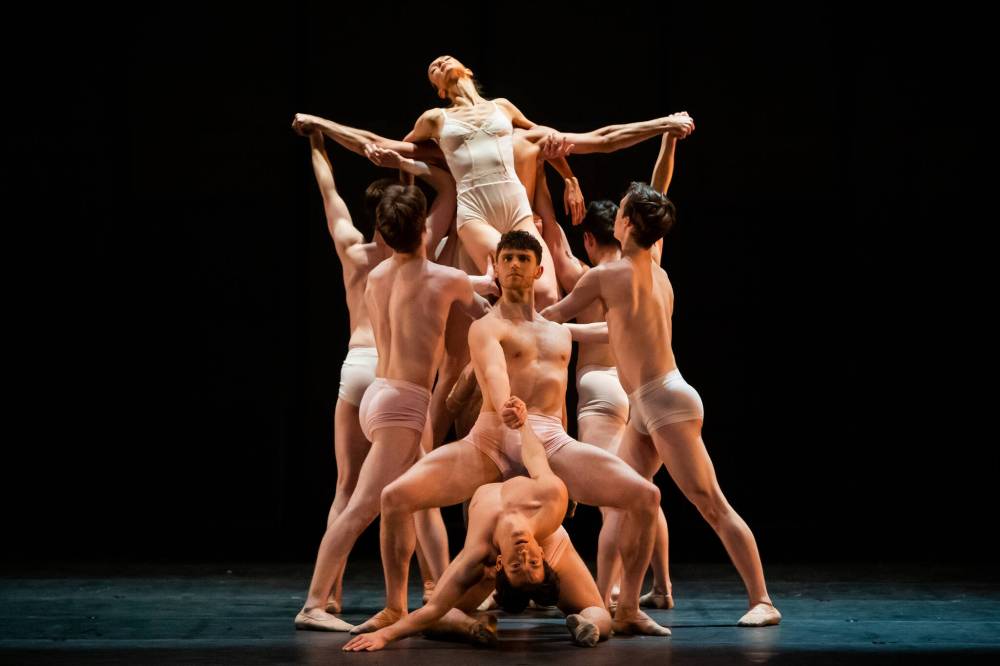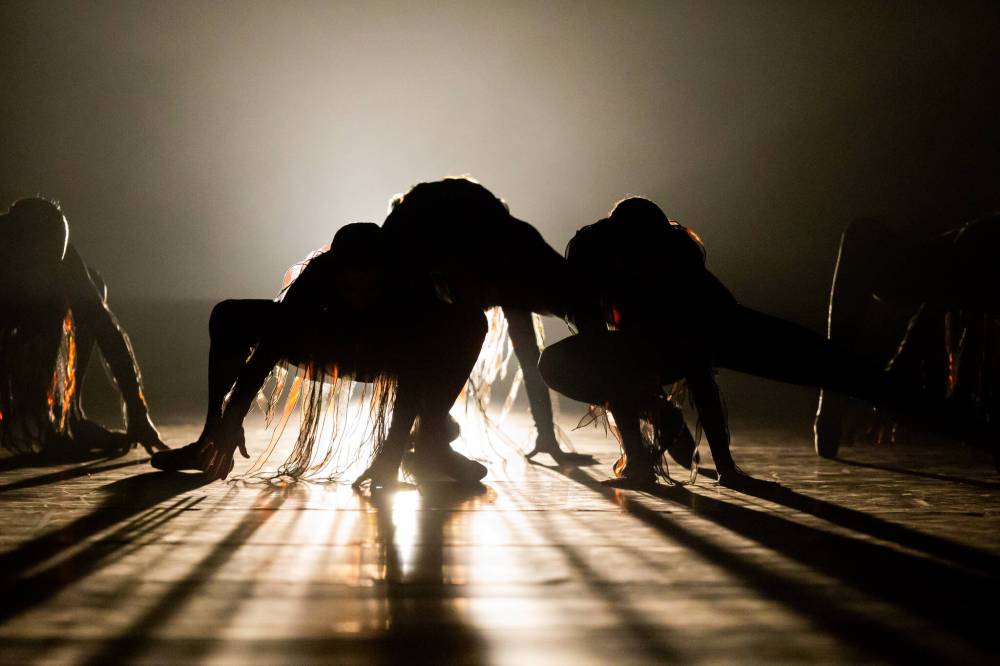New & old
Ballet double-header pairs steamy classic with eerie première
Advertisement
Read this article for free:
or
Already have an account? Log in here »
To continue reading, please subscribe:
Monthly Digital Subscription
$19 $0 for the first 4 weeks*
- Enjoy unlimited reading on winnipegfreepress.com
- Read the E-Edition, our digital replica newspaper
- Access News Break, our award-winning app
- Play interactive puzzles
*No charge for 4 weeks then billed as $19 every four weeks (new subscribers and qualified returning subscribers only). Cancel anytime.
Read unlimited articles for free today:
or
Already have an account? Log in here »
The Royal Winnipeg Ballet went out with a bang Thursday night, as it did what it’s done best throughout its illustrious 85-year history: present blockbuster ballets while championing new works by cutting-edge new choreographers.
Audiences were treated to two contemporary works during the final offering in the company’s Living the Dream season, which has celebrated the legacy of longtime artistic director André Lewis all year long.
It’s been six years since we’ve seen Argentine choreographer Mauricio Wainrot’s monumental Carmina Burana, originally commissioned by the Royal Ballet of Flanders in Belgium in 1998, and given its Canadian première by the RWB in 2002. The 55-minute work never fails to get the heart pumping with its high-octane blend of athletic and sensual choreography exploding with joy.

DANIEL CRUMP PHOTO
Carmina Burana returns to the Royal Winnipeg Ballet stage.
Guest soloists include soprano Andrea Lett, tenor Nolan Kehler and baritone Matthew Pauls, along with local choral groups Prairie Voices and the Winnipeg Boys Choir, all joined by the Winnipeg Symphony Orchestra, with RWB principal conductor Julian Pellicano impeccably leading the combined forces through Carl Orff’s electrifying score.
The production features Carlos Gallardo’s architecturally inspired sets, with large, wheeled frames of sliding panels suggesting a postmodern, urban skyline, as well as his costume design that includes billowing taffeta skirts and simple white trousers, tunics and skirts. The effective lighting is by David Morrison.
The highly visceral ballet, performed in soft ballet/jazz slippers, highlights the vitality of the company, from its iconic opener Fortuna I, frequently heard in Hollywood film scores and ad jingles, through to stirring finale Fortuna II.
An early highlight is In Taberna, showcasing the artistry of principal dancer Elizabeth Lamont and soloist Peter Lancksweerdt, as well as the first entry of the ballet’s featured ensemble couples, including beloved soloist Yayoi Ban, who retires from the stage this year after 19 seasons.
Lancksweerdt’s opening solo, fuelled by fiery leaps and dervish-like spins, stamps this dancer as one to watch. The principal packs her own punch during their fierce pas de deux, before straddling his body in victory. The couple is held sky-high by the ensemble, which injects their duet with raw, primal energy, aligned with the score’s often satirical, bawdy Latin texts.
In contrast, Cour D’amours teems with unabashedly romantic, lyrical tenderness as second soloists Katie Simpson and Marco Lo Presti fluidly entwine their lithe bodies around like sensuous serpents before the stage fills again for the finale.
As expected, the artists received a rousing standing ovation by the enthralled crowd.
The 140-minute (including intermission) mixed bill also feartures the world première of Canadian choreographer Cameron Fraser-Monroe’s T’əl: The Wild Man of the Woods, based on a traditional tale from the Indigenous artist’s home, the Tla’amin Nation in southwestern British Columbia.
The RWB School alumnus, who has served as company choreographer-in-residence this season, has also created works for the National Ballet of Canada, and Ballet Kelowna, among others, with his eclectic artistry blending elements of Ukrainian dance, traditional Indigenous grass and hoop dance, and classical ballet technique.
This isn’t the first time we’ve seen Indigenous-themed ballets on this stage. The Ecstasy of Rita Joe (1971) and the more recent Going Home Star – Truth and Reconciliation (2014) — another Lewis-commissioned world première — immediately spring to mind. However what makes this story ballet unique is that its entire roster of lead creators boast Indigenous heritage, not least of all its magical, 94-year-old story teller, elder Elise Paul, whose recorded narration permeates the work with her ages-old story shared in English and Ayajuthem, the language of the Tla’amin Nation.
Another pillar is Juno-nominated Indigenous composer/cellist Cris Derksen, who performs her original score in the pit alongside the WSO; a sonic stew of rafter-raising powwow drum songs and chant (with credit to Northern Voice and Sheldon & Frazer Sundown), her amplified cello loops, electronic soundscape effects and driving backbeats all melded with classical music influences in an often surprising, white-hot combustion of disparate cultural forces.

DANIEL CRUMP PHOTO
T’əl: The Wild Man of the Woods is the world première of Canadian choreographer Cameron Fraser-Monroe.
Audience members are well-advised to peruse the synopsis in the program notes in advance to help them follow the narrative twists. The ballet’s plotline of a darkly menacing force kidnapping innocent children cannot help but reverberate as a prescient allegory for the horrors of Canada’s residential school system, in which Indigenous children were stolen from their birth families.
Many compelling moments resonate during the 49-minute work. Lamont, with her pristine classical technique, particularly shines as Erica (all lead roles alternating), who ultimately saves the village’s children from the forest monster T’el (pronounced “tall”); her keen acting abilities crafting a plucky heroine with a backbone of steel and fire in her blood.
Another nod goes to principal dancer Alanna McAdie for her dignified portrayal of Erica’s Mother, while corps de ballet member Logan Savard’s T’əl lurks in the shadows in designer Asa Benally’s ghastly costume, replete with streaming “snakes” that snap like whips during his whirling leaps. As a central figure, this demon might have gone even further, to become a more sinister, wilder, larger-than-life presence.
Fraser-Monroe’s often highly rhythmical choreography is at its best during the smaller, more intimate ensemble sections, including duos and trios that counter a bounty of unison movement phrases — canonic entries help — in the larger group sections. Daring lifts performed with precision by the company are also extremely effective, as are moments of visual counterpoint created when smaller groups of dancers are juxtaposed against each other.
One of the most potent images comes as T’əl is tricked by Erica and burned in fire; a sextet of dancers en pointe suddenly morph into licking flames before transforming into “Noseeums,” a.k.a. mosquitos, as a final remnant of this archetypal figure.
The story ends on a triumphant note as one of T’əl’s stolen, Erica’s Middle Sister (corps de ballet member Brooke Thomas), is lifted aloft while the villagers celebrate the return of all their children. Fraser-Monroe’s revealing homage to his ancestral roots and its rich legacy of oral tradition garnered another standing ovation by the opening night crowd, perhaps inspired to stare down a few T’əls of their own.
holly.harris@shaw.ca





